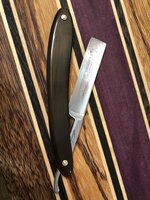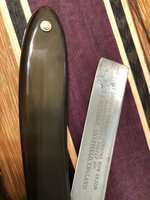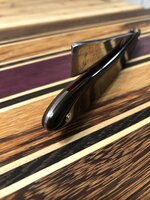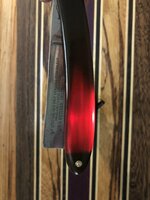I got this hundred-year-old razor some time ago and still don't know what to do with it. The only thing I know for sure is that I will scale it in a horn, hone it, and shave with it. But before that I need to choose what to do with the blade. On one hand, there's a beautiful engraving with the "Royal" and the Coat of The Most Noble Order of the Garter, and on the other, there's this pitting. I don't know anything about the razor belonging to the royal family or their barbers, but I want to save the engraving as much as possible. What would you advise to clean the razor and whether it should be cleaned at all?

You are using an out of date browser. It may not display this or other websites correctly.
You should upgrade or use an alternative browser.
You should upgrade or use an alternative browser.
Royal Hugo Koller restoration.
- Thread starter CON.
- Start date
Personally its not a razor I would try to fix. Some of the engraving is already gone like the banners on emblem. Also the edge is not straight and will require fixing, or convex honing or rolling pull strokes to hone.
If you intend to use the razor then pitting must be your first priority...
If you intend to use the razor then pitting must be your first priority...
- Thread starter
- #3
Personally its not a razor I would try to fix.
Maybe the photo doesn't do her honor but the razor has perfect geometry. It' s obviously been proper honed, and being worn to engraving, it' s still 5/8. The question was how to clean the pitting while keeping the engraving. I was thinking of a brush with diamond paste or something like that. Never worked with an engraving like that.
CON - there is no magic answer awaiting you unfortunately that will surely clean the blade and save the engraving perfectly. Luckily it appears to be deeply engraved vs shallow or even more difficult like etching or gold wash.
You are just going to have to start cleaning/sanding at it and see how it goes. If pitting is deeper than the engraving then obviously there is no way to sand pits out and not the engraving.
My suggestion - give it some light sanding and polish and see how it goes. Start at the polishing end and work backwards to see what it really needs without making it a scratchy mess unnecessarily. Try even starting with liquid metal polish before high grit W/D and see if it will clean up OK with acceptable level of patina for you. But I’ll tell you the obvious again, it is a balance between pitting removal and engraving destruction because you can’t remove one and not the other.
Something many do is to tape off areas they want to preserve and then work hard all around it. Yours is most of the blade but something to consider. It has already been honed well into the engraving anyway, so I wouldn’t feel bad sanding and grinding that blade myself.
You are just going to have to start cleaning/sanding at it and see how it goes. If pitting is deeper than the engraving then obviously there is no way to sand pits out and not the engraving.
My suggestion - give it some light sanding and polish and see how it goes. Start at the polishing end and work backwards to see what it really needs without making it a scratchy mess unnecessarily. Try even starting with liquid metal polish before high grit W/D and see if it will clean up OK with acceptable level of patina for you. But I’ll tell you the obvious again, it is a balance between pitting removal and engraving destruction because you can’t remove one and not the other.
Something many do is to tape off areas they want to preserve and then work hard all around it. Yours is most of the blade but something to consider. It has already been honed well into the engraving anyway, so I wouldn’t feel bad sanding and grinding that blade myself.
Here is an example from this weekend. This blade had rust all over and I wire brushed off the thick stuff and put it in rust remover late Friday. Saturday got a little free time and cleaned up the blade and cut some scales from a slab of dyed red horn. Spent a little Father’s Day time in the shop yesterday shaping, finishing, pinning.
There was light pitting all over the blade and I’m sorry I didn’t do any before pics. I took most of that out but you see several deep pits remaining out near the toe area of the engraving. Those are deeper than the engraving. Here the trade off was to keep the pitting. Is it pretty - no. But to grind that out would not just kill the engraving but the blade too.






There was light pitting all over the blade and I’m sorry I didn’t do any before pics. I took most of that out but you see several deep pits remaining out near the toe area of the engraving. Those are deeper than the engraving. Here the trade off was to keep the pitting. Is it pretty - no. But to grind that out would not just kill the engraving but the blade too.
Attachments
I'd probably soak it in some rust remover, but nothing too acidic.. Perhaps just some WD40, to loosen up the rust somewhat.
Then I'd have a go at it with a softer wire brush, probably one of the brass ones. Add some paste to it, but no metal polish, if you ask me. I'd use kanahada instead. It's coarser, but made up of wrought iron dust and oil, so it shouldn't scratch the good steel too much - hence preserving the engraving. On the other hand, it's harder than the oxidized steel, so it will get some rust out of the pits.
In terms of actually sanding anything on that one, I'd probably restore the tang, mask off the engraving and restore lightly around it, leaving the engraving intact.
It's difficult to judge how much can be done over the engraving, but it's quite possible that using a well shaped piece of stone around 1K or 2K grit, would clean up that face nicely, without compromising the engraving. Point is, you gotta grind away with something flat and rigid.
Sent from my CLT-L29 using Tapatalk
Then I'd have a go at it with a softer wire brush, probably one of the brass ones. Add some paste to it, but no metal polish, if you ask me. I'd use kanahada instead. It's coarser, but made up of wrought iron dust and oil, so it shouldn't scratch the good steel too much - hence preserving the engraving. On the other hand, it's harder than the oxidized steel, so it will get some rust out of the pits.
In terms of actually sanding anything on that one, I'd probably restore the tang, mask off the engraving and restore lightly around it, leaving the engraving intact.
It's difficult to judge how much can be done over the engraving, but it's quite possible that using a well shaped piece of stone around 1K or 2K grit, would clean up that face nicely, without compromising the engraving. Point is, you gotta grind away with something flat and rigid.
Sent from my CLT-L29 using Tapatalk
- Thread starter
- #7
Here is the main issue, it is a custom engraving and the pitting surface is below the engraving. I've never seen this on a razor, you can see the frame near the barbers notch, it's on the same level as the inscriptions with the coat of arms. I don't know if this can be understood from the current photo, but now I can't do any new to make it clear.If pitting is deeper than the engraving then obviously there
Is the soaking in WD40 effective? I already wiped it with a wd rag.probably soak it in
Yes, I understand what you are saying about the pitting completely. And like I said above....if pitting is below the art work on the blade there is virtually no way to make it look new again. Unless you can sand in between somehow. Probably not the answer you were wanting but I think that is the case.
You can do some polishing or even light sanding and probably improve the aesthetics. But is is a trade between cleaning the blade up and destroying the artwork. You have to make that call.
WD40 does not dissolve rust that I know of. I use a solution made for rust removal and reacts with oxides. Theoretically this leave only clean steel and should help prevent the rust from continuing.
Good luck!
You can do some polishing or even light sanding and probably improve the aesthetics. But is is a trade between cleaning the blade up and destroying the artwork. You have to make that call.
WD40 does not dissolve rust that I know of. I use a solution made for rust removal and reacts with oxides. Theoretically this leave only clean steel and should help prevent the rust from continuing.
Good luck!
WD40 will loosen up active rust, but it won't affect passive rust. Often there's active rust hiding beneath what looks like passive rust, and WD40 will help loosen that up. It will find its way in there, but soaking works better than just wiping, because it gives it time to work. It does depend on the state of the razor, too. I'm afraid only you can be the judge of that, but there's certainly no harm in trying.
Stronger solutions, like the one mentioned above, will work well and likely remove a lot more. I just don't like that.. The blade looks too clean, but still pitted. It's not the most pleasant look, esthetically.. But that's just my opinion.
Sent from my CLT-L29 using Tapatalk
Stronger solutions, like the one mentioned above, will work well and likely remove a lot more. I just don't like that.. The blade looks too clean, but still pitted. It's not the most pleasant look, esthetically.. But that's just my opinion.
Sent from my CLT-L29 using Tapatalk
Similar threads
- Replies
- 8
- Views
- 838
- Replies
- 5
- Views
- 942
- Replies
- 6
- Views
- 832
- Replies
- 1
- Views
- 1K
- Replies
- 14
- Views
- 911




